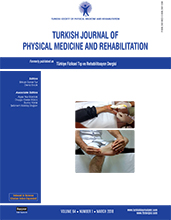Effects of isokinetic, isometric, and aerobic exercises on clinical variables and knee cartilage volume using magnetic resonance imaging in patients with osteoarthritis
2 Department of Physical Medicine and Rehabilitation, Koç University School of Medicine, İstanbul, Turkey
3 Department of Radiology, Medical Faculty of Gazi University, Ankara, Turkey
4 Department of Physical Medicine and Rehabilitation, Medical Faculty of Gazi University, Ankara, Turkey DOI : 10.5606/tftrd.2018.795 Objectives: This study aims to evaluate the effect of isokinetic, isometric, and aerobic exercise protocols on pain, disability, physical function, and articular cartilage in osteoarthritis.
Patients and methods: A total of 45 women (mean age 52.1 years; range 45 to 65 years) who were admitted to the Physical Medicine and Rehabilitation outpatient clinic and were diagnosed with primary bilateral knee osteoarthritis between May 2008 and January 2010 were included. The patients were randomly divided into three groups as isokinetic (n=15), aerobic (n=15), and isometric exercise groups (n=15). Exercise protocols were applied five days a week for four weeks. Pain was evaluated using a 10 cm Visual Analog Scale for Pain (VAS-pain), pain, joint stiffness and physical function was assessed using the Western Ontario and McMaster Universities Osteoarthritis Index (WOMAC), and disability was assessed using the Lequesne Index before and after the interventions. Isokinetic knee muscle strength measurements were also obtained. Patellar and femoral cartilage volumes were analyzed using magnetic resonance imaging.
Results: The VAS-pain, WOMAC, and Lequesne scores and peak torque values of knee extension improved in all groups with the highest improvement in the isokinetic group. For the knee flexion peak torque values, improvements were significant only in the isokinetic group at both velocities. There was no significant change in the femoral cartilage volume in any group after the interventions. However, patellar cartilage volume significantly increased in the isometric group (p=0.036).
Conclusion: A four-week isokinetic, aerobic, and isometric exercise programs improved pain and functional capacity in patients with knee osteoarthritis. Isokinetic exercise also increased the muscle strength with improved maintenance of the quadriceps/hamstring ratio. Only isometric exercise increased the patellar cartilage volume.
Keywords : Cartilage; exercise; knee osteoarthritis; magnetic resonance imaging

















